Giới Thiệu (Introduction)
Modifiers are automatic operations that affect an object's geometry in a non-destructive way. With modifiers, you can perform many effects automatically that would otherwise be too tedious to do manually (such as subdivision surfaces) and without affecting the base geometry of your object.
They work by changing how an object is displayed and rendered, but not the geometry which you can edit directly. You can add several modifiers to a single object to form The Modifier Stack and Apply a modifier if you wish to make its changes permanent.
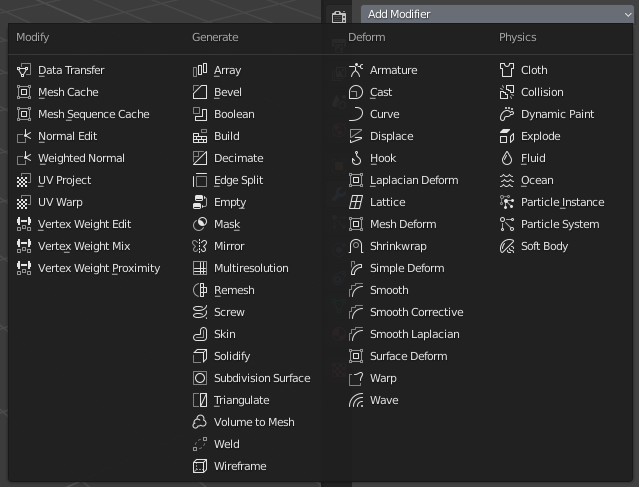
Sao Chép Bộ Điều Chỉnh.
They can be added to the active object using the Add Modifier drop-down menu at the top of their properties tab. New modifiers are always added at the bottom of the stack (i.e. will be applied last).
There are four categories of modifiers:
- Sửa Đổi (Modify)
These are tools similar to the Deform ones (see below), however, they usually do not directly affect the geometry of the object, but some other data, such as vertex groups.
- Sinh Tạo (Generate)
These are constructive/destructive tools that will affect the whole Topology of the mesh. They can change the general appearance of the object, or add new geometry to it...
- Biến Dạng (Deform)
Unlike Generate ones above, these only change the shape of an object, without altering its topology.
- Mô Phỏng (Simulate)
Those represent physics simulations. In most cases, they are automatically added to the modifiers stack whenever a Particle System or Physics simulation is enabled. Their only role is to define the position in the modifier stack from which is taken the base data for the simulation they represent. As such, they typically have no attributes, and are controlled by settings exposed in separate sections of the Properties.
Giao Diện (Interface)
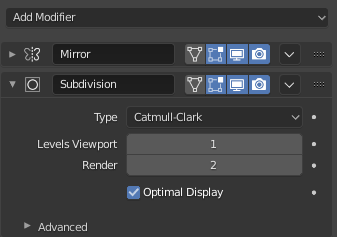
Panel layout (Subdivision Surface as an example).
Each modifier's interface shares the same basic components, see Fig. Panel layout (Subdivision Surface as an example)..
At the top is the panel header. The icons each represent different settings for the modifier (left to right):
- Mở Rộng [biểu tượng hình mũi tên dưới/phải] (Expand [down/right arrow icon])
Collapse modifier to show only the header and not its options.
- Thể Loại (Type)
An icon as a quick visual reference of the modifier's type.
- Tên (Name)
Every modifier has a unique name per object. Two modifiers on one object must have unique names, but two modifiers on different objects can have the same name. The default name is based on the modifier type.
- Hiển Thị trên Lồng [biểu tượng hình tam giác] -- Duy các Khung Lưới (Show on Cage [vertices triangle icon] -- Meshes only)
Depends on the previous setting, if enabled, the modified geometry can also be edited directly, instead of the original one.
Cảnh báo
While it shows edited items in their final, modified positions, you are still actually editing original data. This can lead to strong and unpredictable effects with some tools, and should be disabled whenever you need to perform complex or precise editing on the mesh.
- Hiển Thị trong Chế Độ Biên Soạn [Biểu Tượng Hình Vuông Điểm Đỉnh] (Show In Edit Mode [Vertices Square Icon])
Display the modified geometry in Edit Mode, as well as the original geometry which you can edit.
- Hiển Thị trong Cổng Nhìn [biểu tượng màn hình] (Show in Viewport [screen icon])
Bật/Tắt mặt phẳng nền trong góc nhìn VR.
- Kết Xuất [biểu tượng máy quay phim] (Render [camera icon])
Bật/Tắt mặt phẳng nền trong góc nhìn VR.
Ghi chú
The Square, Triangle and Surface icons may not be available, depending on the type of object and modifier.
- Áp Dụng Trên Các Điểm của Đường Cong Spline [biểu tượng điểm chấm bên trái dải bề mặt] -- duy các đường cong, bề mặt và văn bản mà thôi (Apply On Spline Points [point surface icon] -- Curves, surfaces and texts only)
Apply the whole modifier stack up to and including that one on the curve or surface control points, instead of their tessellated geometry.
Ghi chú
By default, curves, texts and surfaces are always converted to mesh-like geometry before that the modifier stack is evaluated on them.
- Bổ Sung (Extras)
- Áp Dụng (Apply) Ctrl-A
Makes the modifier "real": converts the object's geometry to match the applied modifier's results, and deletes the modifier.
When applying a modifier to an object that shares Object Data between multiple objects, the object must first be made a Single User which can be performed by confirming the pop-up message.
Cảnh báo
Applying a modifier that is not first in the stack will ignore the stack order (it will be applied as if it was the first one), and may produce undesired results.
- Áp Dụng thành Hình Mẫu (Apply as Shape Key)
Stores the result of that modifier in a new relative shape key and then deletes the modifier from the modifier stack. This is only available with modifiers that do not affect the topology (typically, Deform modifiers only).
Ghi chú
Even though it should work with any geometry type that supports shape keys, currently it will only work with meshes.
- Lưu thành Hình Mẫu (Save as Shape Key)
Stores the result of that modifier in a new relative shape key and keeps the modifier in the modifier stack. This is only available with modifiers that do not affect the topology (typically, Deform modifiers only).
- Nhân Đôi (Duplicate) Shift-D
Creates a duplicate of the modifier just below current one in the stack.
- Sao Chép Sang cái được Chọn (Copy to Selected)
Copies the modifier from the Active object to all selected objects.
- Di Chuyển về Đầu/Cuối (Move to First/Last)
Moves the modifier to the first or last position in the modifier stack.
- Xóa (Delete) X, Xóa (Delete)
Xóa Nút Không Sử Dụng.
- Di Chuyển
:::: Move the modifier up/down in the stack, changing the evaluation order of the modifiers.
Below this header, all of the options unique to each modifier will be displayed.
Ngăn Xếp Bộ Điều Chỉnh (The Modifier Stack)
Modifiers are a series of non-destructive operations which can be applied on top of an object's geometry. You can be apply them in almost any order. This kind of functionality is often referred to as a "modifier stack" and is also found in several other 3D applications.
In a modifier stack, the order in which modifiers are applied has an effect on the result.
Therefore the modifiers can be re-arranged by clicking the grab widget (::::) in the top right,
and moving the selected modifier up or down.
For example, the image below shows Subdivision Surface
and Mirror modifiers that have switched places.
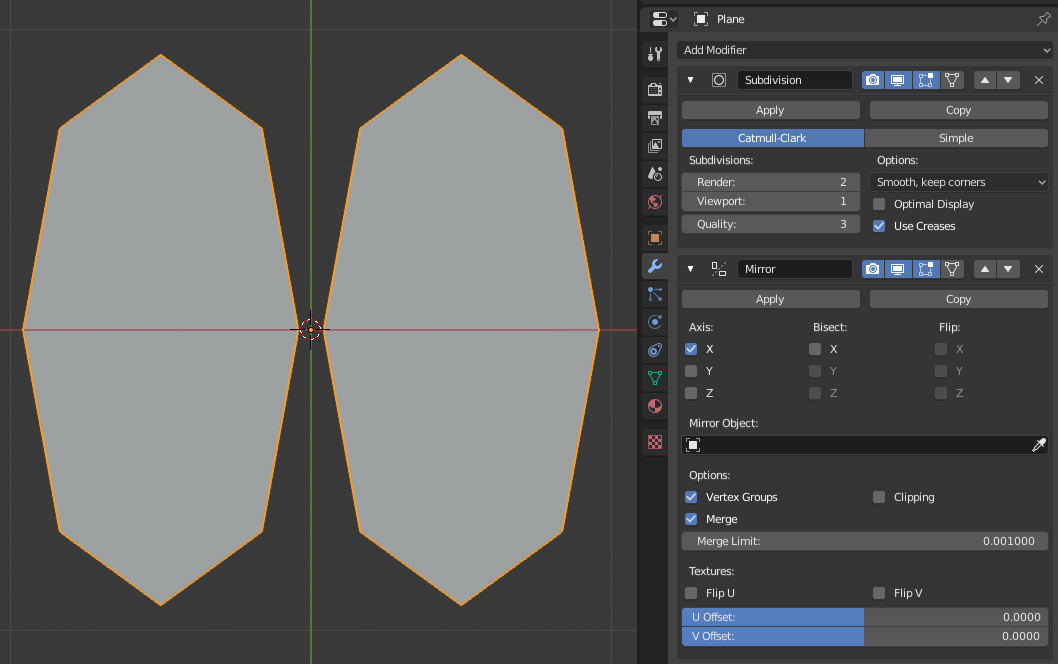
The Mirror modifier is the last item in the stack and the result looks like two surfaces. |
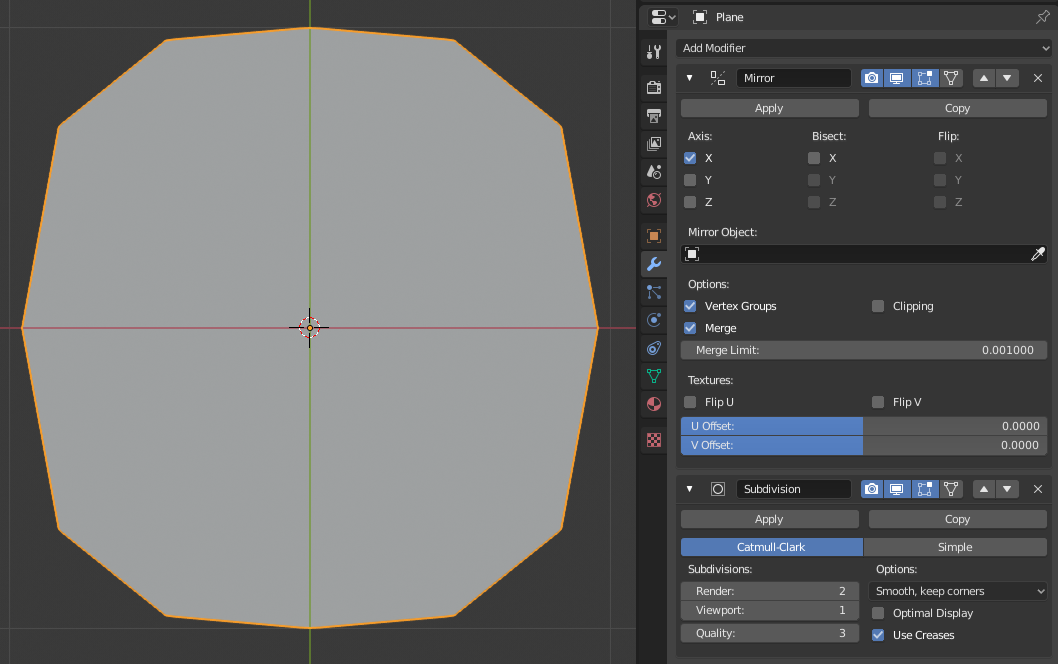
The Subdivision Surface modifier is the last item in the stack and the result is a single merged surface. |
Modifiers are calculated from top to bottom in the stack. In this example, the desired result (on right) is achieved by first mirroring the object, and then calculating the subdivision surface.
Bộ Điều Chỉnh đang hoạt động (Active Modifier)
A modifier in the stack can be selected to mark in as Active, the active modifier displays an outline around the modifier's panel. To set an active modifier, select an area of the modifier's panel background, the modifier's icon, or, select a modifier in the Mục Lục (Outliner).
The active modifier is used by the Trình Biên Soạn Nút Hình Học (Geometry Node Editor) to determine which node group is being modified.
Ví Dụ (Example)
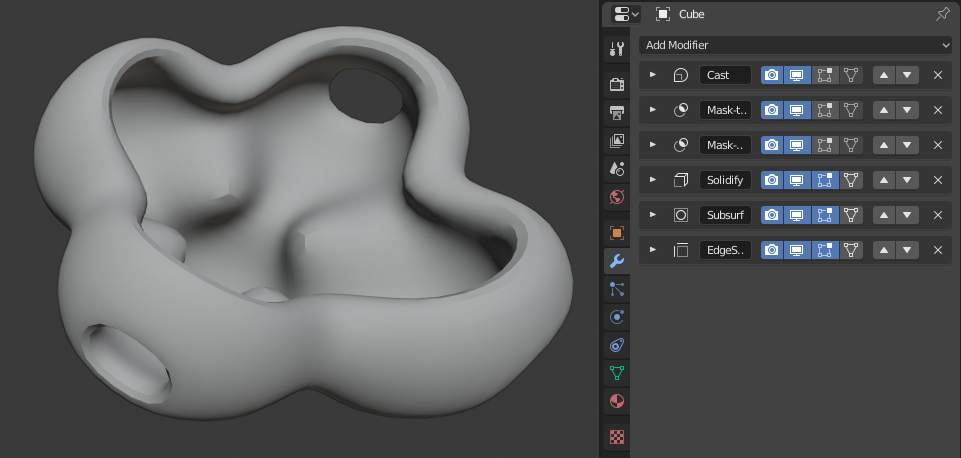
In this example a simple subdivided cube has been transformed into a rather complex object using a stack of modifiers.